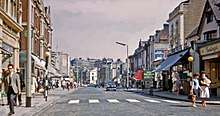Radnor Walk
Radnor Walk is a residential street in the Royal Borough of Kensington & Chelsea off the King's Road in London. The houses are mid and late Victorian and the street is part of the Royal Hospital Conservation Area. It was originally called Radnor Street, and was named after John Robartes, 1st Earl of Radnor who died in Chelsea in 1685. It was renamed Radnor Walk in 1937.[1]

It runs parallel to Shawfield Street and Smith Street.
Buildings and residents
The street includes a Grade II listed former Welsh Congregational church.[2]
The well known local restaurant Zianni is situated at number 45, while at the top of the street is the Founder's Hall of the notable Hill House School. Famous residents include John Betjeman.
Photographer and film director Terence Donovan and designer Maurice Jeffery opened a boutique, The Shop, at 47 Radnor Walk in the 1960s.[3]
Radnor Studios, dating from mid to late 19th century, were artists' studios. Together with two late Georgian terrace houses, numbers 3 and 5, they were replaced in 1970 with a four-storey block designed by the architects Hayes Stafford.
Occupants of the Studios included:[4][5][6][7]
- James Wedgwood c1927–c1932
- William Leslie Bowles, Australian sculptor 1920–1923
- Hibbert Charles Binney c1894–1897
- Herbert Harry Cawood c1920–c1926
- Cecil Hew Brown c1923
- John Francis Kavanagh, Irish sculptor and artist c1937–c1943
- Francis Derwent Wood, British sculptor 1894
References
- "111–115 (ODD) KINGS ROAD AND 1–5 (ODD) RADNOR WALK. Historic Buildings Report" (PDF). Royal Borough of Kensington and Chelsea. July 2013.
- Historic England (28 October 2008). "Former Welsh congregationall Church (1392962)". National Heritage List for England. Retrieved 23 July 2020.
- "Studio days: Chelsea's artistic links". Mayfair Times. June 2017. Retrieved 23 July 2020.
- "1 Radnor Studios, London, England". Mapping the Practice and Profession of Sculpture in Britain and Ireland 1851–1951, University of Glasgow History of Art and HATII, online database 2011.
- "3 Radnor Studios, Radnor Street, Chelsea, London SW3, England". Mapping the Practice and Profession of Sculpture in Britain and Ireland 1851–1951, University of Glasgow History of Art and HATII, online database 2011.
- "4 Radnor Studios, Radnor Street, King\'s Road, Chelsea, London SW3, England". Mapping the Practice and Profession of Sculpture in Britain and Ireland 1851–1951, University of Glasgow History of Art and HATII, online database 2011.
- "Radnor Studios, Radnor Street, Chelsea, London SW, England". Mapping the Practice and Profession of Sculpture in Britain and Ireland 1851–1951, University of Glasgow History of Art and HATII, online database 2011.